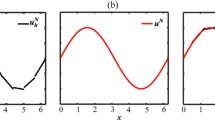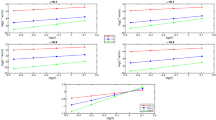Abstract
This paper presents a numerical solution of time-fractional nonlinear advection–diffusion equations (TFADEs) based on the local discontinuous Galerkin method. The trapezoidal quadrature scheme (TQS) for the fractional order part of TFADEs is investigated. In TQS, the fractional derivative is replaced by the Volterra integral equation which is computed by the trapezoidal quadrature formula. Then the local discontinuous Galerkin method has been applied for space-discretization in this scheme. Additionally, the stability and convergence analysis of the proposed method has been discussed. Finally some test problems have been investigated to confirm the validity and convergence of the proposed method.

















Similar content being viewed by others
References
Debnath L (2003) Recent application of fractional calculus to science and engineering. Int J Math Math Sci 54:3413–3442
Hilfer R (2000) Applications of fractional calculus in physics. World Scientific Publishing Co., London
Gorenflo R, Mainardi F (1996) Fractional oscillation and Mittag-Leffler functions, Fachbereich Mathematik and Informatic, A14/96. Freie Universitaet, Berlin
Sabatier J, Agrawal OP, Machado JT (2007) Advances in fractional calculus, theoretical developments and applications in physics and engineering. Springer, London
Zaslavsky GM (2008) Hamiltonian chaos and fractional dynamics. Oxford Univ. Press, Oxford
Abelman S, Selvakumaran KA, Rashidi MM, Purohit SD (2017) Subordination conditions for a class of non-bazilevic type defined by using fractional q-calculus operators. Facta Univ Ser Math Inform 32:255–267
Singh J, Rashidi M, Kumar D, Swroop R (2016) A fractional model of a dynamical Brusselator reaction-diffusion system arising in triple collision and enzymatic reactions. Nonlinear Eng Model Appl 5:277–285
Sarwar S, Rashidi M (2016) Approximate solution of two-term fractional-order diffusion, wave-diffusion, and telegraph models arising in mathematical physics using optimal homotopy asymptotic method. Waves Rand Complex Med 26:365–382
Leibniz GW (1697) Letter from Hanover, Leibniz Mathematische Schriften, Germany to John Wallis
Euler L (1730) M\(\acute{e}\)moire dans le tome V des comment, saint petersberg Annees 55
Laplace PS (1812) Th\(\acute{e}\)orie Analytique des probabilit\(\acute{e}\)s, courcier, Paris
Liouville J (1823) Mémoire sur le calcul des différentielles á indices quelconques. J. École Polytechnique 13(21):71–162
O’Shaughnessy L, Post EL (1918) Problem 433. Am Math Mon 25:172–173
McBride AC, Roach G (1985) Fractional calculus, research notes in math. Pitman, Boston
Nishimoto K (1991) An essence of Nishimoto’s fractional calculus. Descartes, Koriyama
Kiryakova V (1994) Generalized fractional calculus and applications, research notes in math. Pitman Longman, Harlow and Wiley, New York
Podlubny I (1999) Fractional differential equations. Academic, San Diego
Kilbas AA, Srivastava HM, Trujillo JJ (2006) Theory and applications of fractional differential equations. Elsevier, Amsterdam
Diethelm K (2010) The analysis of fractional differential equations, an application oriented exposition using differential operators of Caputo type. Springer, Berlin
Kazem S (2013) An integral operational matrix based on Jacobi polynomials for solving fractional-order differential equations. Appl Math Model 37:1126–1136
Kazem S, Abbasbandy S, Kumar S (2013) Fractional-order Legendre functions for solving fractional-order differential equations. Appl Math Model 37:5498–5510
Eshaghi J, Adibi H, Kazem S (2016) Solution of nonlinear weakly singular Volterra integral equations using the fractional-order Legendre functions and pseudospectral method. Math Methods Appl Sci 39:3411–3425
** B, Lazarov R, Liu Y, Zhou Z (2015) The Galerkin finite element method for a multi-term time-fractional diffusion equation. J Comput Phys 281:825–843
** B, Lazarov R, Pasciak J, Zhou Z (2014) Error analysis of a finite element method for the space-fractional parabolic equation. SIAM J Numer Anal 52:2272–2294
Zhao Y, Bu W, Huang J, Liu D-Y, Tang Y (2015) Finite element method for two-dimensional space-fractional advection-dispersion equations. Appl Math Comput 257:553–565
** B, Lazarov R, Zhou Z (2013) Error estimates for a semidiscrete finite element method for fractional order parabolic equations. SIAM J Numer Anal 51:445–466
** B, Lazarov R, Pasciak J, Zhou Z (2015) Error analysis of semidiscrete finite element methods for inhomogeneous time-fractional diffusion. IMA J Numer Anal 35:561–582
Zhang X, He Y, Wei L, Tang B, Wang S (2014) A fully discrete local discontinuous Galerkin method for one-dimensional time-fractional Fisher’s equation. Int J Comput Math 91:2021–2038
Eshaghi J, Adibi H, Kazem S (2017) On a numerical investigation of the time fractional Fokker–Planck equation via local discontinuous glerkin method. Int J Comput Math 94(9):1916–1942
Yang A-M, Zhang Y-Z, Cattani C, **e G-N, Rashidi MM, Zhou Y-J, Yang X-J (2014) Application of local fractional series expansion method to solve Klein–Gordon equations on cantor sets. Abstr Appl Anal 2014:372741
Kumar S, Kumar D, Abbasbandy S, Rashidi MM (2014) Analytical solution of fractional Navier–Stokes equation by using modified Laplace decomposition method. Ain Shams Eng J 5:569–574
Li BQ (2006) Discontinuous finite elements in fluid dynamics and heat transfer. Springer, Berlin
Cockburn B (1998) Discontinuous Galerkin methods for convection-dominated problems. Lect Notes Comput Sci Eng 9:69–224
Cockburn B, Shu C-W (1998) The local discontinuous Galerkin method for time-dependent convection–diffusion systems. SIAM J Numer Anal 35:2440–2463
Oldham KB, Spanier J (1974) The fractional calculus. Academic, New York
Linz P (1985) Analytical and numerical methods for Volterra equations. SIAM, Philadelphia
Reed W, Hill T (1973) Triangular mesh methods for the neutron transport equation, Technical Report LA-UR-73-479. Alamos Scientific Laboratory, New Mexico
Cockburn B, Shu C-W (1989) TVB Runge-Kutta local projection discontinuous Galerkin finite element method for conservation laws II: general framework. Math Comp 52:411–435
Cockburn B, Shu C-W (1998) The Runge-Kutta discontinuous Galerkin method for conservation laws V: multidimensional systems. J Comput Phys 141:199–224
Cockburn B, Shu C-W (2001) Runge-kutta discontinuous Galerkin methods for convection-dominated problems. J Sci Comput 16:173–261
Yan J, Shu C-W (2002) Local discontinuous Galerkin methods for partial differential equations with higher order derivatives. J Sci Comput 17:27–47
Xu Y, Shu C-W (2005) Local discontinuous Galerkin methods for nonlinear Schrodinger equations. J Comput Phys 205:72–97
Xu Y, Shu C-W (2006) Local discontinuous Galerkin methods for the Kuramoto–Sivashinsky equations and the Ito-type coupled KdV equations. Comput Methods Appl Mech Eng 195:3430–3447
Xu Y, Shu C-W (2007) Error estimates of the semi-discrete local discontinuous Galerkin method for nonlinear convection-diffusion and KdV equations. Comput Methods Appl Mech Eng 196:3805–3822
Xu Y, Shu C-W (2010) Local discontinuous Galerkin methods for high-order time-dependent partial differential equations. Commun Comput Phys 7:1–46
Warburton T, Embree M (2006) The role of the penalty in the local discontinuous Galerkin method for Maxwell’s eigenvalue problem. Comput Methods Appl Mech Eng 195:3205–3223
Aizinger V, Dawson C (2007) The local discontinuous Galerkin method for three-dimensional shallow water flow. Comput Methods Appl Mech Eng 196:734–746
Baccouch M (2010) A local discontinuous Galerkin method for the second-order wave equation. Comput Methods Appl Mech Eng 209–212:129–143
Baccouch M (2014) A superconvergent local discontinuous Galerkin method for the second-order wave equation on Cartesian grids. Comput Math Appl 68:1250–1278
Guo R, Xu Y, Xu Z (2015) Local discontinuous Galerkin methods for the functionalized Cahn–Hilliard equation. J Sci Comput 63:913–937
Liang X, Khaliq A, **ng Y (2015) Fourth order exponential time differencing method with local discontinuous Galerkin approximation for coupled nonlinear Schrodinger equations. Commun Comput Phys 17:510–541
Guo H, Yu F, Yang Y (2017) Local discontinuous Galerkin method for incompressible miscible displacement problem in porous media. J Sci Comput 71:615–633
Li XH, Shu C-W, Yang Y (2017) Local discontinuous Galerkin method for the Keller–Segel chemotaxis model. J Sci Comput. https://doi.org/10.1007/s10915-016-0354-y
Cao W, Huang Q (2017) Superconvergence of local discontinuous Galerkin methods for partial differential equations with higher order derivatives. J Sci Comput. https://doi.org/10.1007/s10915-017-0377-z
Bi H, Qian C, Sun Y (2016) The optimal error estimate and superconvergence of the local discontinuous Galerkin methods for one-dimensional linear fifth order time dependent equations. Comput Math Appl 72:687–703
Wei L, He Y (2014) Analysis of a fully discrete local discontinuous Galerkin method for time-fractional fourth-order problems. Appl Math Model 38:1511–1522
Wei L, He Y, Zhang Y (2013) Numerical analysis of the fractional seventh-order KdV equation using an implisit fully discrete local discotinuous Galerkin method. Int J Numer Anal Model 10:430–444
Wei L, He Y, Zhang X, Wang S (2012) Analysis of an implicit fully discrete local discontinuous Galerkin method for the time-fractional Schrodinger equation. Finite Elem Anal Des 59:28–34
Wei L, Dai H, Zhang D, Si Z (2014) Fully discrete local discontinuous Galerkin method for solving the fractional telegraph equation. Calcolo 51:175–192
Wei L, Zhang X, Kumar S, Yildirim A (2012) A numerical study based on an implicit fully discrete local discontinuous Galerkin method for the time-fractional coupled Schrodinger system. Comput Math Appl 64:2603–2615
Guo L, Wang Z, Vong S (2016) Fully discrete local discontinuous Galerkin methods for some time-fractional fourth-order problems. Int J Comput Math 93:1665–1682
Cockburn B, Kanschat G, Perugia I, Schotzau D (2001) Superconvergence of the local discontinuous Galerkin method for elliptic problems on cartesian grids. SIAM J Numer Anal 39:264–285
Ciarlet P (1978) The finite element method for elliptic problem, studies in mathematics and its application. North-Holland, Amsterdam
Yao Cheng XM, Zhang Q (2017) Application of generalized Gauss–Radau projections for the local discontinuous galerkin method for linear convection-diffusion equations. Math Comput 86:1233–1267
Kurganov A, Tadmor E (2000) New high-resolution central schemes for nonlinear conservation laws and convection-diffusion equations. J Comput Phys 160:241–282
Acknowledgements
The authors are grateful to the reviewers for their comments and suggestions which have improved the paper.
Author information
Authors and Affiliations
Corresponding author
Additional information
Publisher's Note
Springer Nature remains neutral with regard to jurisdictional claims in published maps and institutional affiliations
Appendix 1: Discrete Gronwall’s inequality
Appendix 1: Discrete Gronwall’s inequality
If \(x_i,~f_i,~g_i,~h_i\) are non-negative sequences which satisfy
then we have
Rights and permissions
About this article
Cite this article
Eshaghi, J., Kazem, S. & Adibi, H. The local discontinuous Galerkin method for 2D nonlinear time-fractional advection–diffusion equations. Engineering with Computers 35, 1317–1332 (2019). https://doi.org/10.1007/s00366-018-0665-8
Received:
Accepted:
Published:
Issue Date:
DOI: https://doi.org/10.1007/s00366-018-0665-8
Keywords
- Time-fractional advection–diffusion equations
- Discontinuous Galerkin method
- Local discontinuous Galerkin method
- Caputo derivative
- Stability and convergence analysis




